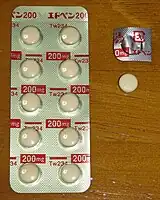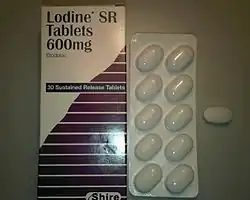Etodolac
 | |
| Names | |
|---|---|
| Trade names | Etolyn, Etopan, Lodine, others |
IUPAC name
| |
| Clinical data | |
| Drug class | Nonsteroidal anti-inflammatory drug (NSAID)[1] |
| Main uses | Pain, inflammation[2] |
| Side effects | Heart burn, abdominal pain, GI bleeding, nausea, kidney problems, dizziness, swelling, bleeding, ringing in the ears, liver problems[1] |
| WHO AWaRe | UnlinkedWikibase error: ⧼unlinkedwikibase-error-statements-entity-not-set⧽ |
| Pregnancy category |
|
| Routes of use | By mouth |
| Typical dose | 600 mg OD[2] |
| External links | |
| AHFS/Drugs.com | Monograph |
| MedlinePlus | a692015 |
| Legal | |
| Legal status | |
| Pharmacokinetics | |
| Protein binding | 100% |
| Metabolism | liver |
| Elimination half-life | 7.3 ± 4.0 hours |
| Excretion | renal |
| Chemical and physical data | |
| Formula | C17H21NO3 |
| Molar mass | 287.359 g·mol−1 |
| 3D model (JSmol) | |
| Melting point | 145 to 148 °C (293 to 298 °F) |
| Solubility in water | 3.92e-02 mg/mL [ALOGPS] mg/mL (20 °C) |
SMILES
| |
InChI
| |
Etodolac, sold under the brand name Etolyn among others, is a nonsteroidal anti-inflammatory drug (NSAID) used to treat pain and inflammation.[2] This may include in conditions such as osteoarthritis or rheumatic arthritis.[2] It is taken by mouth.[2]
Common side effects include heart burn, abdominal pain, GI bleeding, nausea, kidney problems, dizziness, swelling, bleeding, ringing in the ears, and liver problems.[1] Other side effects may include heart attacks, high blood pressure, heart failure, and anaphylaxis.[1] Use in the later half of pregnancy may harm the baby.[1] It works by blocking COX1 and COX2.[1]
Etodolac was patented in 1971 and approved for medical use in 1985.[3] It was approved in the U.S. in 1991.[1] It is available as a generic medication.[4] In the United Kingdom 30 tablets of 600 mg costs the NHS about £15 as of 2021.[2] This amount in the United States costs about 22 USD.[4]
Medical uses
Etodolac is used to treat inflammation and pain such as caused by osteoarthritis and rheumatoid arthritis.[2]
Dosage
It is used at a dose of 600 mg per day extended release.[2]
Interactions
Etodolac should be avoided by patients with a history of asthma attacks, hives, or other allergic reactions to aspirin or other NSAIDs. Rare but severe allergic reactions have been reported in such individuals. It also should be avoided by patients with peptic ulcer disease or poor kidney function, since this medication can worsen both conditions. Etodolac is used with caution in patients taking blood thinning medications (anticoagulants), such as warfarin (Coumadin), because it increases the risk of bleeding. Patients taking both lithium and etodolac may develop toxic blood lithium levels. Additionally, etodolac has been found to interact with certain anti-depressant medications, such as sertraline or fluoxetine, which can increase risks of stroke, heart attack, and other cardiovascular conditions. Patients also taking ciclosporin (Sandimmune) can develop kidney toxicity. Use in children has not been adequately studied. Etodolac is not habit-forming. NSAIDs should be discontinued prior to elective surgery because of a mild interference with clotting that is characteristic of this group of medicines. Etodolac is best discontinued at least four days in advance of surgery. Etodolac metabolites may also cause a false positive bilirubin result on a urinalysis test.[5]
Pregnancy and nursing
Etodolac is generally avoided during pregnancy and nursing. NSAIDs may cause adverse cardiovascular effects in the fetus during pregnancy. [6]
In October 2020, the U.S. Food and Drug Administration (FDA) required the drug label to be updated for all nonsteroidal anti-inflammatory medications to describe the risk of kidney problems in unborn babies that result in low amniotic fluid.[7][8] They recommend avoiding NSAIDs in pregnant women at 20 weeks or later in pregnancy.[7][8]
Mechanism of action
They work by reducing the levels of prostaglandins, which are chemicals that are responsible for pain and the fever and tenderness that occur with inflammation. Etodolac blocks the cyclooxygenase (abbrev. COX) enzymes which form prostanoids, resulting in lower concentrations of prostaglandins. As a consequence, inflammation, pain and fever are reduced.
Post-marketing studies demonstrated that etodolac inhibition of cyclooxygenase is somewhat COX-2 selective [9] similar to celecoxib and other "COX-2 inhibitors." Unlike rofecoxib, both etodolac and celecoxib can fully inhibit COX-1 and are designated as having "preferential selectivity" toward COX-2. The R-enantiomer of etodolac is inactive against COX enzymes, but inhibits beta-catenin levels in hepatoma cells.[10]
Society and culture
Cost
The cost of this medication in the U.S. is $16 (USD) for 14 tablets (400 mg) [11]
.svg.png.webp) Etodolac costs (DrugStats)
Etodolac costs (DrugStats).svg.png.webp) Etodolac prescriptions (DrugStats)
Etodolac prescriptions (DrugStats)
Brand names
Etodolac is manufactured by Almirall Limited under the trade name Lodine SR[12] and by Meda Pharmaceuticals under the name Eccoxolac.[13] Generic etodolac is also available.[14]
The drug is also sold under several other brand names, including:
- Etogesic (India)
- Etova (India)
- Dualgan (Portugal)
- Etodin (South Korea)
- Etofree (India)
- Etopan (Israel)
- Flancox[15] (Brazil)
- Haipen (Japan)
- Lodine (France, Switzerland, United States)
- Proxym (S Etodolac) (India)
- Etol (Turkey)
- Lonine (Taiwan)
- Etodine (Egypt)
- Dolarit (Turkey)
- "Etodin Fort" (Bulgaria)
 Generic etodolac
Generic etodolac Box, strip and tablet of etodolac (Lodine SR) 600mg
Box, strip and tablet of etodolac (Lodine SR) 600mg
References
- 1 2 3 4 5 6 7 "Etodolac Monograph for Professionals". Drugs.com. Archived from the original on 28 August 2021. Retrieved 16 December 2021.
- 1 2 3 4 5 6 7 8 BNF 81: March-September 2021. BMJ Group and the Pharmaceutical Press. 2021. p. 1184. ISBN 978-0857114105.
- ↑ Fischer J, Ganellin CR (2006). Analogue-based Drug Discovery. John Wiley & Sons. p. 517. ISBN 9783527607495. Archived from the original on 2021-07-26. Retrieved 2020-12-29.
- 1 2 "Etodolac Prices, Coupons & Savings Tips - GoodRx". GoodRx. Retrieved 16 December 2021.
- ↑ Sho Y, Ishiodori T, Oketani M, Kubozono O, Nakamura A, Takeuchi A, et al. (July 1999). "Effects of urinary metabolites of etodolac on diagnostic tests of bilirubin in urine". Arzneimittel-Forschung. 49 (7): 572–6. doi:10.1055/s-0031-1300464. PMID 10442203.
- ↑ Ogbru O. "etodolac, Lodine (Discontinued): Drug Facts, Side Effects and Dosing". MedicineNet. Archived from the original on 2019-03-06. Retrieved 2020-12-29.
- 1 2 "FDA Warns that Using a Type of Pain and Fever Medication in Second Half of Pregnancy Could Lead to Complications". U.S. Food and Drug Administration (FDA) (Press release). 15 October 2020. Archived from the original on 16 October 2020. Retrieved 15 October 2020.
 This article incorporates text from this source, which is in the public domain.
This article incorporates text from this source, which is in the public domain. - 1 2 "NSAIDs may cause rare kidney problems in unborn babies". U.S. Food and Drug Administration. 21 July 2017. Archived from the original on 17 October 2020. Retrieved 15 October 2020.
 This article incorporates text from this source, which is in the public domain.
This article incorporates text from this source, which is in the public domain. - ↑ Warner TD, Giuliano F, Vojnovic I, Bukasa A, Mitchell JA, Vane JR (June 1999). "Nonsteroid drug selectivities for cyclo-oxygenase-1 rather than cyclo-oxygenase-2 are associated with human gastrointestinal toxicity: a full in vitro analysis". Proceedings of the National Academy of Sciences of the United States of America. 96 (13): 7563–8. Bibcode:1999PNAS...96.7563W. doi:10.1073/pnas.96.13.7563. PMC 22126. PMID 10377455.
- ↑ Behari J, Zeng G, Otruba W, Thompson MD, Muller P, Micsenyi A, et al. (May 2007). "R-Etodolac decreases beta-catenin levels along with survival and proliferation of hepatoma cells". Journal of Hepatology. 46 (5): 849–57. doi:10.1016/j.jhep.2006.11.017. PMC 1924913. PMID 17275129.
- ↑ "Etodolac Prices, Coupons & Patient Assistance Programs". Drugs.com. Archived from the original on 28 August 2021. Retrieved 30 March 2021.
- ↑ "Lodine SR". medicines.org.uk. Archived from the original on 2008-03-18. Retrieved 2008-08-07.
- ↑ "Eccoxolac". medicines.org.uk. Archived from the original on 2012-12-24.
- ↑ "Etodolac preparations". BNF 55.
{{cite web}}: CS1 maint: url-status (link) - ↑ "Flancox". apsen.com.br. Archived from the original on 2016-09-16. Retrieved 2020-12-29.
External links
| Identifiers: |
|---|
- Medicinenet.com Archived 2019-03-06 at the Wayback Machine